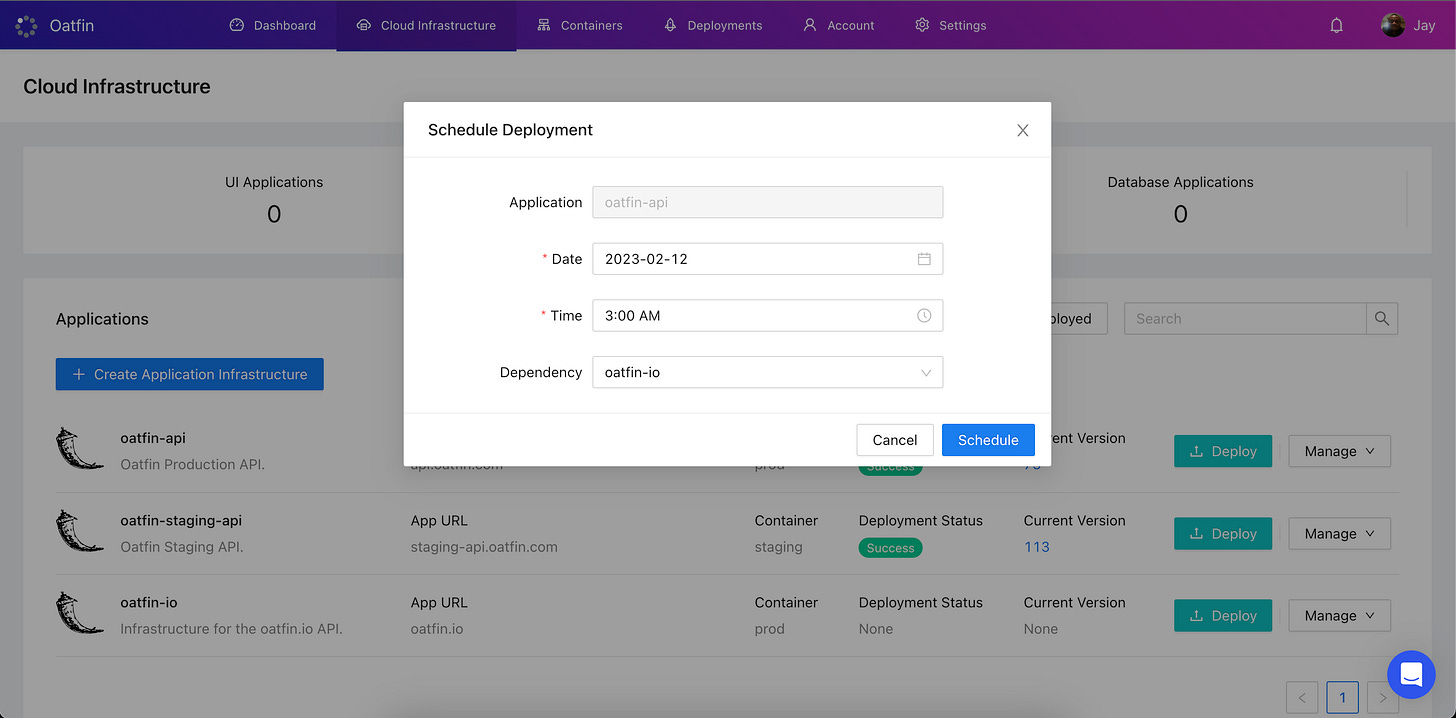As promised, in this week’s edition of Cloud Musings, I thought I would do a deep dive with code into dynamic scheduling and explain how we solve this challenge. Don’t forget to subscribe here on Substack of Linkedin. Thanks for reading!
Last week, I wrote about this on a very high level. Here is a demo of how it works. I’ve also started to open source some of our code base so people can understand how our platform works.
We have a pretty solid architecture:
- Python, Flask API
- MongoDB database
- Celery, Redis task queue
- React, Typescript Frontend
- Docker on AWS ECS and Digital Ocean
The UI:

To schedule a deployment, a user specifies a cloud infrastructure, the date, time, and dependency. Dependency is optional, but we could imagine the case of deploying the API before a change in the UI or a database change before deploying the API. When a user specifies a dependency, it runs 15 minutes before the actual deployment.
For the frontend, I’m using React, Typescript with a tool called umijs and ant design from Ant financial:
The scheduled deployment request function just calls the backend API passing the user inputs along with the access token for security and to know who the user is.
import { request } from 'umi';
export async function schedule(data: API.ScheduledDataType) {
return request('/v1/scheduled_deployments', {
method: 'POST',
data,
headers: {
Authorization: 'Bearer oatfin_access_token'
},
});
}
The user specifies a date (year, month, day) and time (hour, minute). We use moment-timezone npm to guess the timezone: moment.tz.guess()
const handleSubmit = async (values: API.DateTimeDependency) => {
const data: API.ScheduledDataType = {
app: current?.id,
year: values.date.year(),
month: values.date.month() + 1,
day: values.date.date(),
hour: values.time.hour(),
minute: values.time.minute(),
timezone: moment.tz.guess(),
dependency: values.dependency,
};
try {
...
const res = await schedule(data);
...
} catch (error) {
message.error('Error scheduling deployment.');
}
};
Inside the React functional component, we specify a function for the onSubmit in the modal where we capture the user inputs.
export const SchedComponent: FC<BasicListProps> = (props) => {
...
const getModalContent = () => {
return (
<Form onFinish={handleFinish}>
<Form.Item name="name" label="Application">
<Input disabled value={current?.name} />
</Form.Item>
<Form.Item name="date" label="Date">
<DatePicker
disabledDate={(currentDate) => disabled(currentDate)}
/>
</Form.Item>
<Form.Item name="time" label="Time">
<TimePicker use12Hours format="h:mm A" showNow={false}/>
</Form.Item>
<Form.Item name="dependency" label="Dependency">
<Select>
<Select.Option key={app.id} value={app.id}>
{app.name}
</Select.Option>
</Select>
</Form.Item>
</Form>
);
};
return(
<Modal
title="Schedule Deployment"
width={640}
bodyStyle={{ padding: '28px 0 0' }}
destroyOnClose
visible={visible}
onCancel={onCancel}
onsubmit={handleSubmit}
>
{getModalContent()}
</Modal>
)
}
The Python, Flask API:
First we capture the parameters that the UI sends, then call the service to create the actual schedule. If the user specifies a dependency, we also create a scheduled entry in MongoDB and Redis for the dependency.
...
@api.route('/scheduled_deployments', methods=['POST'])
@jwt_required()
def schedule_deployment():
user_id = get_jwt_identity()['user_id']
req_data = flask.request.get_json()
app_id = req_data.get('app')
dependency = req_data.get('dependency')
year = req_data.get('year')
month = req_data.get('month')
day = req_data.get('day')
hour = req_data.get('hour')
minute = req_data.get('minute')
timezone = req_data.get('timezone')
sd = ScheduledDeploymentService().create_schedule(...)
args = [...]
SchedulerService().create_entry(sd, args=args, app=app)
if sd.dependency is not None:
dep = sd.dependency
args = [...]
SchedulerService().create_entry(dep, args=args, app=app)
return flask.jsonify(
result=sd.json(),
), 200
The create_schedule method in ScheduledDeploymentService creates an entry in MongoDB for the parent deployment and any dependency the user specified.
def create(app_id, dep, user_id, year, month, day, hour, minute, tz):
if dependency:
sched = ScheduledDeployment(
app=dependency_app,
team=user.team,
year=dependency_sched.year,
month=dependency_sched.month,
day=dependency_sched.day,
hour=dependency_sched.hour,
minute=dependency_sched.minute,
original_timezone=tz
).save()
return ScheduledDeployment(
app=app,
dependency=sched,
team=user.team,
year=year,
month=month,
day=day,
hour=hour,
minute=minute,
original_tz=tz
).save()
The MongoDB document:
from mongoengine import Document, IntField, ReferenceField, etc.
class ScheduledDeployment(Document):
year = IntField()
month = IntField()
day = IntField()
hour = IntField()
minute = IntField()
original_timezone = StringField()
entry_key = StringField()
dependency = ReferenceField('self', required=False)
def json(self):
return {
'year': self['year'],
'month': self['month'],
'day': self['day'],
'hour': self['hour'],
'minute': self['minute'],
'original_timezone': self['original_timezone'],
'entry_key': self['entry_key']
}
The DeploymentSchedulerService is used to first translate the user date and time from their timezone to UTC, then it creates an entry in Redis. We’re also using crontab from celery to create the actual schedule. The challenge here is that we can only specify month_of_year, day_of_month, hour, and minute. We can’t specify a year. We handle this by deleting the entry from Redis once the scheduled deployment is successful.
class SchedulerService(object):
def create_scheduled_entry(self, sd, args, app):
scheduled_date = self.to_utc(...)
entry = RedBeatSchedulerEntry(
name=str(sd.id),
schedule=crontab(
month_of_year=scheduled_date.month,
day_of_month=scheduled_date.day,
hour=scheduled_date.hour,
minute=scheduled_date.minute,
),
task='tasks.deploy',
args=args,
app=app
)
entry.save()
sd.update(set__entry_key=entry.key)
def to_utc(self, timezone, year, month, day, hour, minute):
tz = pytz.timezone(timezone)
user_dtz = tz.localize(datetime.datetime(...))
return tz.normalize(user_dtz).astimezone(pytz.utc)
Finally the task queue looks like this:
app = Celery(__name__)
app.conf.broker_url = app_config.REDIS_BROKER
app.conf.result_backend = app_config.REDIS_BACKEND
app.conf.redbeat_redis_url = app_config.REDIS_BACKEND
app.conf.update()
@app.task(name='tasks.deploy')
def deploy(user_id, app_id, key, secret, region, deployment_id=None, scheduled_id=None):
connect(
db=app_config.DB_NAME,
username=app_config.DB_USERNAME,
password=app_config.DB_PASSWORD,
host=app_config.DB_HOST,
port=app_config.DB_PORT,
authentication_source=app_config.DB_AUTH_SOURCE
)
ECSDeploymentService().deploy(
user_id=user_id,
app_id=app_id,
oatfin_key=key,
oatfin_secret=secret,
oatfin_region=region,
deployment_id=deployment_id,
scheduled_id=scheduled_id
)
Thanks for reading!
Jay